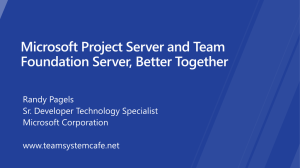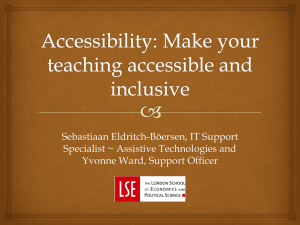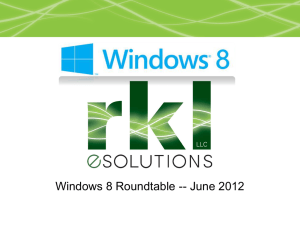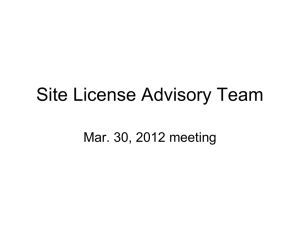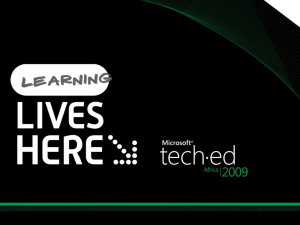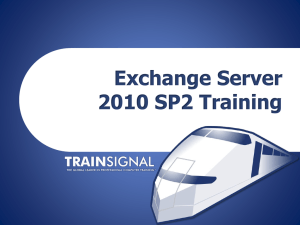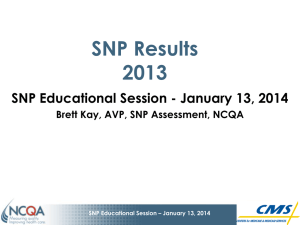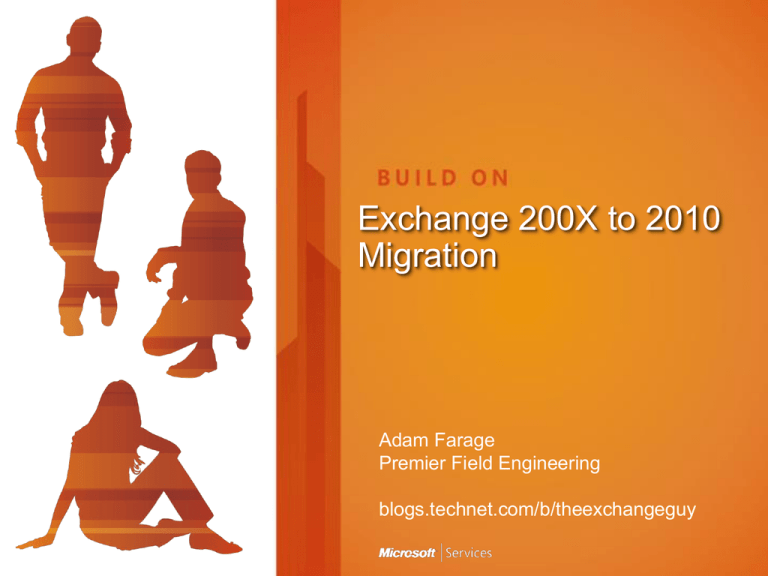
Exchange 200X to 2010
Migration
Adam Farage
Premier Field Engineering
blogs.technet.com/b/theexchangeguy
Legal Notice
Information in this document, including URL and other website references, represents the current view of Microsoft Corporation as of
the date of publication and is subject to change without notice to you.
Descriptions or references to third party products, services or websites are provided only as a convenience to you and should not be
considered an endorsement by Microsoft. Microsoft makes no representations or warranties, express or implied, as to any third party
products, services or websites.
The names of actual companies and products mentioned herein may be the trademarks of their respective owners. Unless otherwise
noted, the example companies, organizations, products, domain names, e-mail addresses, logos, people, places, and events depicted
herein are fictitious.
Complying with all applicable copyright laws is the responsibility of the user. This document is intended for distribution to and use only
by Microsoft Premier customers. Use or distribution of this document by any other persons is prohibited without the express written
permission of Microsoft. Without limiting the rights under copyright, no part of this document may be reproduced, stored in or introduced
into a retrieval system, or transmitted in any form or by any means (electronic, mechanical, photocopying, recording, or otherwise), or
for any purpose, without the express written permission of Microsoft Corporation.
Microsoft may have patents, patent applications, trademarks, copyrights, or other intellectual property rights covering subject matter in
this document. Except as expressly provided in any written license agreement from Microsoft, this document does not give you any
license to Microsoft’s intellectual property.
MICROSOFT MAKES NO WARRANTIES OF ANY KIND, EXPRESS OR IMPLIED, AS TO THE INFORMATION CONTAINED IN THIS
DOCUMENT.
© 2009 Microsoft Corporation. All rights reserved.
Agenda
Pre-Requisites for Exchange 200X and 2010 Coexistence
Pre-Requisites for Exchange 2010
Installing Exchange 2010
Other things you might be interested in
Pre-Requisites for Exchange 200X/2010
Coexistence
Exchange Coexistence Requirements
You can only have Exchange Coexistence if you are running
-
Exchange 2007 SP2
-
Exchange 2003 SP2
If you are running Exchange 2003/2007 without a SP2, then you need to
upgrade it to SP2 to ensure properly application compatibility
If you are running Exchange 2000 or 5.5, please remove these from the
environment before deploying Exchange 2010
Pre-Requisites for Exchange 200X/2010
Coexistence (cont)
Directory Services Requirements
Forest Functionality – 2003 Native or greater
-
We do not support 2003 Mixed Functionality Mode or anything lower
Schema Master
-
Windows Server 2003 – Standard/Enterprise with SP2 (x86/x64)
-
Windows Server 2008 (R2) – Standard/Enterprise (x86/x64)
Domain Controller
-
Windows Server 2003 – Standard/Enterprise with SP2 (x86/x64)
-
Windows Server 2008 (R2) – Standard/Enterprise with SP1 (x86/x64)
-
Windows Server 2008 (R2) Datacenter RTM or later
Global Catalog Server
-
Windows Server 2003 – Standard/Enterprise with SP2 (x86/x64)
-
Windows Server 2008 (R2) – Standard/Enterprise (x86/x64)
Pre-Requisites for Exchange 200X/2010
Coexistence (cont)
Support for Outlook or Entourage
Supported Versions of Outlook
-
Outlook 2010
-
Outlook 2007
-
Outlook 2003
-
Outlook for Mac 2011
Supported Versions of Entourage
-
Entourage 2007 for Mac, Web Services Edition
Pre-Requisites for Exchange 2010
Operating System Requirements
OS that supports 64 bit, one of the following:
-
64-bit edition of Windows Server 2008 Standard/Enterprise with SP2 or R2
with SP1
-
Windows Server 2008 Datacenter RTM or later
Management Toolset
-
Windows Vista with SP2 or 64-bit Windows 7
-
64-bit edition of Windows Server 2008 Standard with SP2
-
64-bit edition of Windows Server 2008 Enterprise with SP2 or Windows
Server 2008 R2 Standard / Enterprise
If you are migrating from Exchange 2003, you have to install KB937031
-
This is to ensure that the Windows Integrated Auth stays ON within the
Exchange 2003 MSAS (Microsoft ActiveSync) Virtual Directory.
-
http://tinyurl.com/EASHotfix (applies to 2010 also)
Pre-Requisites for Exchange 2010 (cont)
Hardware
CPU – 64 bit
Memory – based off the role (URL: http://tinyurl.com/E14MEM)
Disk space: role based but
-
At least 1.2GB of space to install Exchange
-
At least 200MB of free space on the system drive (typically C:)
-
Remember – use mailbox calculator
File Format: NTFS
Networking: IPv4 / IPv6 – we do not support “pure” IPv6, so don’t
disable IPv4. We also highly recommend NOT disabling IPv6 due to
possible complications.
Installing Exchange 2010
Upgrade Process
Installing Exchange 2010 (cont)
Step One – Upgrading Existing Exchange Service packs
As discussed, simply make sure Exchange 2003 and/or Exchange 2007
is upgraded to at least SP2.
The reason for this is because of needed changes to the Exchange
2003/2007 needs certain “upgrades” to interface with Exchange 2010,
which is taken care of in SP2 of these applications.
If you have Exchange 2000 or lower servers left in the organization,
remove them to ensure proper compatibility and supportability
Installing Exchange 2010 (cont)
Step Two – Deploying the Roles
Deploy all the exchange roles in the following order:
-
Client Access Server(s)
-
HUB Transport Server(s)
-
UM Server(s)
-
Mailbox Server(s)
REMEMBER: Each site should contain the following to ensure that it
actually works as designed:
-
At least ONE Client Access Server (only ONE array is allowed per site)
-
At least ONE Transport Server (you should have more than one for redundancy)
-
At least ONE Mailbox Server Role at each site (you should have more than one for
redundancy)
Why CAS first, and Mailbox last? CAS is so much harder to configure than
the mailbox role, Mr. PFE.
-
Simple: Exchange 2007 CAS can only talk to Exchange 2007 Mailbox roles, and
not 2010 Mailbox Roles. If you install the 2010 Mailbox role and move users
without a CAS, then no 2010 users can access their data.
Installing Exchange 2010 (cont)
Step Three – Configuring CAS
Namespace planning
-
-
-
Most organizations I have ran into simply move the namespace from Exchange 200X to 2010, and then
put a “legacy” namespace in their old environment they are migrating from.
Example: if your Exchange 2007 CAS had OWA pointing to mail.contoso.com, you would normally move
the FQDN mail.contoso.com from the 2007 organization to the 2010 organization, and then make the old
OWA FQDN legacymail.consoto.com.
Protip: write your namespace planning down on paper, it makes it easier than trying to remember it all.
Services Configuration
-
Once you have the namespace planned, you would want to configure the CAS services you would use:
•
Outlook Web App / Exchange Control Panel
•
ActiveSync
•
AutoDiscover / Outlook Anywhere
Certificate Renewal
-
Once you have your namespace planned and your CAS services configured you should go off and
purchase your certificate
I recommend using SAN (Subject Alternative Name) certificates, since you have multiple names on the
cert.
You can also use your PKI if you have it in place.
Protip: avoid wildcard certificates (*.contoso.com) as it doesn’t always play nicely with Exchange or the
Load Balancer(s) in the market today.
Installing Exchange 2010 (cont)
Step Four – Cutover Time
CAS Cutover
-
Configure the Internet based namespace (usually from your old organization)
in the new environment
-
Move the A/CNAME records to the new IP addresses
-
Configure your firewall to ensure that the proper external IP is pointed to the
proper internal IP
-
Move your OAB Generation and OAB Copies
HUB Cutover
-
Move the send/receive connectors from the old 200X organization to 2010
-
If you are running Exchange 2003, make sure you create a legacy routing
connector to ensure mail flow between the two organizations
-
Repoint your MX records to the proper IP address, if changed
Installing Exchange 2010 (cont)
Step Five – Mailbox Migration
Once we have tested that Client Access is working, and that mail is
flowing we are ready to start the migration Process
We can either use Exchange Management Console or Exchange
Management Shell to Migrate these users over.
Other things you might be interested in
CAS (Array) static TCP Ports
A recommendation we have, and one I make often is to create static
TCP ports for your CAS Array. This helps out in the configuration of the
load balancer, and also helps when reading network traces
You need a static RPC CA ports
-
RPC Client Access (RPC Endpoint Mapper): pick a number between the
range of 6005-59530
-
Address Book Distribution/Service: pick a number between the range of 600559530
-
Public Folder Access – pick a number between the range of 49152-65535
Check to make sure the port is available by using netstat –an
As a reminder: all client connections go through the Client Access
Server EXCEPT Public Folders!
Reference: http://tinyurl.com/StaticRPC
Other things you might be interested in
(cont)
Enabling Kerberos for CAS Array
Reason we make this recommendation is because we notice a
performance hit using NTLM
We recommend enabling Kerberos Authentication on Exchange 2010
SP1 and later
Reference Material:
-
http://tinyurl.com/MSExchangeORG
-
http://tinyurl.com/MSExchangeTeam
Other things you might be interested in
(cont)
Exchange Server Deployment Assistant
Exchange Server Deployment Assistant (ExDeploy) helps create a deployment strategy for the
following situations:
-
On-Premises Only
•
•
•
•
-
Upgrade from Exchange Server 2003
Upgrade from Exchange 2007
Upgrade from mixed Exchange 2003 and Exchange Server 2007
New installation of Exchange 2010
Hybrid Deployment (On-Premises + Cloud)
•
•
•
Exchange 2003
Exchange 2007
Exchange 2010
http://tinyurl.com/E14DeployAssist
Links and references
Good links and references
Exchange Compatibility Charts
-
http://tinyurl.com/E14Compatibility
Exchange 2010 Prerequisites
-
http://tinyurl.com/E14Prereqs
Exchange 2010 Installation Checklist
-
http://tinyurl.com/E14InstallChecklist
Exchange 2010 Installation Checklist
-
http://tinyurl.com/E14InstallChecklist
Exchange 2003 to 2010 Roadmap
-
http://tinyurl.com/Ex2003Roadmap
Exchange 2007 to 2010 Roadmap
-
http://tinyurl.com/Ex2007Roadmap
Exchange Deployment Assistant
-
http://tinyurl.com/E14DeployAssist
© 2008 Microsoft Corporation. All rights reserved. Microsoft, Windows, Windows Vista and other product names are or may be registered trademarks and/or trademarks in the U.S. and/or other countries.
The information herein is for informational purposes only and represents the current view of Microsoft Corporation as of the date of this presentation. Because Microsoft must respond to changing market
conditions, it should not be interpreted to be a commitment on the part of Microsoft, and Microsoft cannot guarantee the accuracy of any information provided after the date of this presentation.
MICROSOFT MAKES NO WARRANTIES, EXPRESS, IMPLIED OR STATUTORY, AS TO THE INFORMATION IN THIS PRESENTATION.


